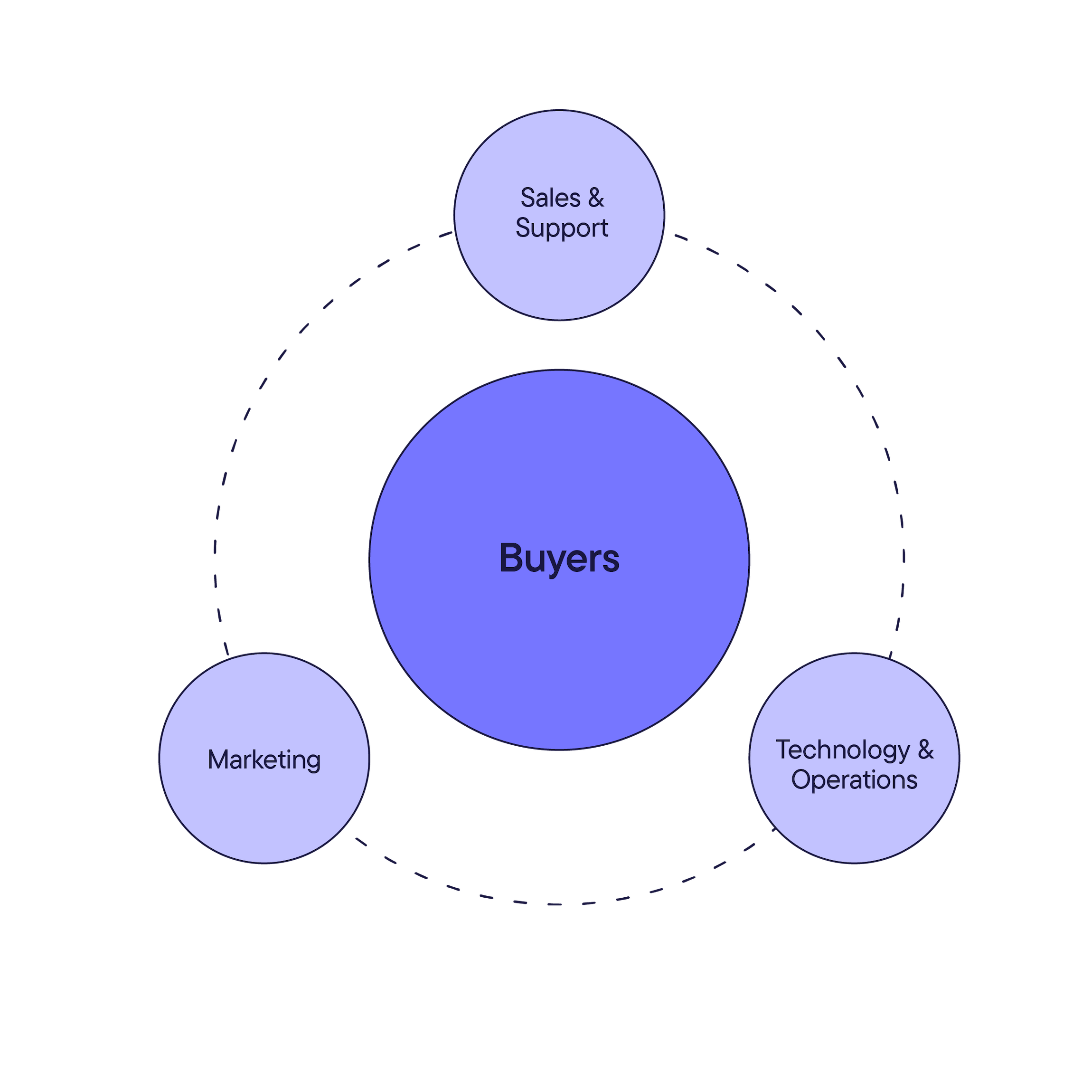Is 2025 the year of bold innovation in B2B digital commerce? Explore five trends and predictions from the commercetools experts that will exceed buyer expectations with advanced experiences.

Since the last publication of our annual report Pivotal Trends and Predictions in B2B Digital Commerce, digital channels have become even more commonplace in B2B commerce. The proof: Organizations are boosting technology investments, with 83% of B2B leaders confirming that their firms planned to spend more money on digital in 2024 than in 2023, aggressively investing in technologies that enable a better customer experience.
This data shows that the B2B sector is overwhelmingly ready to embrace digital after years of management resistance and tight budgets due to economic uncertainty. Another reason for increased investment is that B2B practitioners are seeing how transformative digital technology is, as they’re being exposed to these experiences from within the B2B ecosystem. Leading organizations are paving the way for truly sophisticated buyer experiences that translate into enhanced efficiency, improved experiences and increased revenues.

While technology expands revenue-generating opportunities in eCommerce, creating a digital presence that highlights your company’s expertise, trustworthiness and unique brand value to deliver outstanding purchasing experiences is what makes B2B outperformers stand out.
That said, the question arises: Is 2025 the year of bold innovation in B2B digital commerce? Our insights featured in the updated report say YES!
In this article, explore five trends, predictions and winning strategies of digital outperformers showcased in the report to pave your way to a successful 2025 in B2B commerce.
#1 The extended B2B experience: Beyond the buyer
2024 showed the B2B sector that satisfying buyers is a 24/7/365 job that consists of omnichannel experiences and personalized interactions reminiscent of B2C commerce. For manufacturers, distributors and wholesalers to succeed in an increasingly digital-first context, the first step is knowing that these capabilities are now table stakes. Likewise, customer centricity is the North Star that started shining last year — and is here to stay for good.
More than the natural evolution of the B2B purchasing experience and the importance of customer centricity, digital leaders must consider how their sellers, marketers and developers are empowered to deliver the ultimate experience to buyers. This requires a holistic approach to digital commerce investments that include no-code/low-code tools, hybrid sales, an effective change management framework and a composable technology stack.

This tried-and-tested approach helps businesses overcome the common impediments in their internal adoption of digital while accelerating the goal of meeting buyers’ needs across teams:
Sales and support teams: Buyers continue to rely on sales representatives when it’s most convenient for them, such as navigating complex purchases. As a result, the role of B2B sales representatives is becoming more consultative and strategic, with a stronger focus on guiding customers with expertise and best practices, and solving their challenges rather than simply taking orders.
Marketing teams: Marketers are increasingly involved in shaping eCommerce alongside their technical peers. They use various solutions, such as customer data platforms (CDPs), analytics and more, to personalize content, map journeys and infuse the company’s brand at every touchpoint.
Technology teams: A flexible backend architecture enables developers to focus on customer-centric improvements, such as seamless purchasing flows, personalized recommendations and real-time order tracking — all without risking disruptions to the core infrastructure.
#2 Unified commerce for B2B
The evolution of B2B technology points toward unified commerce — a strategy that integrates all sales channels, customer data, inventory management and backend operations into a single, cohesive commerce platform. With centralized data and processes, businesses can deliver real-time order tracking, inventory visibility and personalized recommendations — whether buyers interact online or offline. For example, a buyer might browse products online, get a quote from a sales representative and then finalize the order through a customer portal.
A unified commerce platform makes all this possible by providing real-time access to critical data, enabling businesses to offer accurate inventory details, personalized pricing and consistent customer support across every touchpoint. The result? Faster purchasing cycles and a smoother buyer experience — key advantages in a sector characterized by lengthy buying processes and high-stakes transactions.
Unified commerce is emerging as essential for B2B organizations because it creates a seamless experience for both buyers and sellers. When a buyer starts a transaction in one channel, like visiting a showroom or demonstration center, and finishes it online, businesses don’t have to worry about losing any data along the way. Everything stays connected, making the process much smoother and more efficient.
Product Manager, commercetools
#3 Extensibility takes automation to the next level
Still today, many B2B practitioners feel the burden of manual work — think paper- and fax-based quote negotiations, order management and so on — that currently account for about two-thirds of sales teams’ time, according to McKinsey. Handling such tasks manually is prone to errors and highly inefficient, so it comes as no surprise that organizations are digitizing and automating processes to gain operational efficiencies.
B2B businesses can surf the wave of advanced automation by tapping into the extensibility of composable technology — a trend expected to climb in 2025. This design approach enables platforms to continuously expand the out-of-the-box features beyond their initial use cases — and build on top of that.
For instance, the high-quality protein supplier Wild Fork Foods embraced the extensibility of composable commerce to implement dynamic pricing and inventory management systems that could accurately handle variable-weight products. The company was able to build a system where the product weight determines the final price at the time of fulfillment and ensures accurate pricing for the customer that minimizes potential revenue loss for the business.
#4 Generative, predictive and more: AI in B2B grows out of the buzzword bingo
GenAI is rapidly growing in the generally risk-averse B2B space, as it helps all the stakeholders in the extended B2B buying experience. Buyers perform various use cases using GenAI, from researching new suppliers to surfacing unstructured data for decision-making, as well as marketers, sellers and developers, who are leveraging the tool to get their jobs done easier and faster.
According to McKinsey, 19% of B2B sales teams are already implementing GenAI use cases. Plus, the likelihood of increasing market share increases 1.7x when data-driven commercial teams blend personalized experiences with GenAI.
However, there’s more to AI than the generative kind. Advanced data analytics is the unsung hero of AI technologies, as it enables companies to predict buying trends, optimize pricing strategies and manage inventory more effectively. While in early stages, augmented AI is a trend worth following closely in hybrid sales, so algorithms can leverage the most current and relevant data for personalized recommendations and customer support.
#5 Digital maturity investments with composable commerce will grow in enterprise-level organizations
In early 2024, the market analyst firm IDC predicted that B2B “midmarket growth companies,” or MMGs for short, are the ones adopting composable technologies faster to increase digital maturity. Indeed, composable implementations across the midmarket sector picked up steam in 2024, propelled by the emergence of pre-composed and low-code/no-code commerce solutions, as well as the rapid rise of B2B-specific accelerators.
Fast forward to today, composable commerce is steadily growing not only in the midmarket sector but increasingly among enterprise-level B2B manufacturers, distributors and wholesalers. After all, the B2B sector continues to follow the evolution of composable spearheaded by brands and retailers, a trend that gained traction a few years ago.
A great example is the industrial manufacturing giant Ingersoll Rand, which leveraged composable technology to try out new solutions, adapt quickly and accelerate product release cycles. For instance, the company rolled out an eCommerce site for one of its business lines in just 100 days.
B2B businesses are under constant pressure to innovate and adapt, and a composable approach gives us the flexibility to try new solutions, test quickly and make changes as needed.
Director of eCommerce, Ingersoll Rand
What’s next: B2B outperformers with bold innovation
From small wins to bold innovation, more and more organizations across industries are leveraging modern technology to create advanced digital experiences that exceed buyer expectations — setting a high bar for the B2B sector as a whole.
